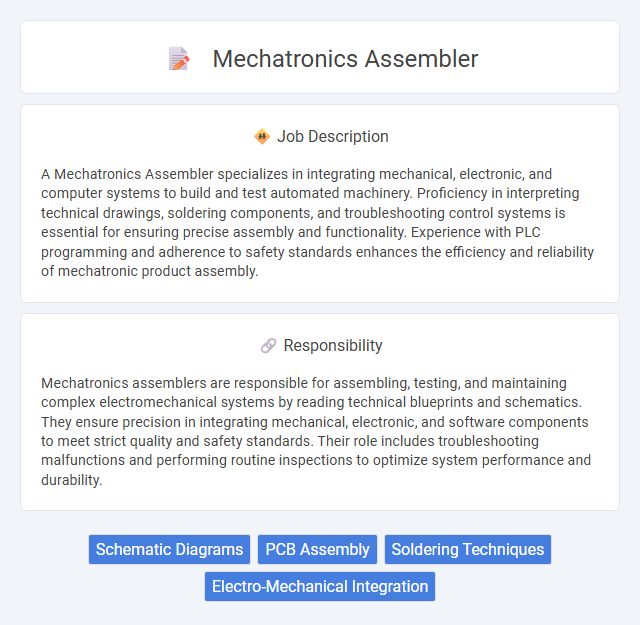
A Mechatronics Assembler specializes in integrating mechanical, electronic, and computer systems to build and test automated machinery. Proficiency in interpreting technical drawings, soldering components, and troubleshooting control systems is essential for ensuring precise assembly and functionality. Experience with PLC programming and adherence to safety standards enhances the efficiency and reliability of mechatronic product assembly.
People with strong problem-solving skills and mechanical aptitude are likely suitable for a Mechatronics assembler job, as the role involves integrating mechanical, electronic, and computer components. Those who can work precisely and adapt to fast-paced manufacturing environments may find this position fitting. Physical stamina and attention to detail increase the probability of success in handling the assembly of complex systems.
Qualification
A Mechatronics assembler requires a solid foundation in mechanical, electrical, and computer engineering principles, often supported by a technical diploma or associate degree in mechatronics or a related field. Proficiency in reading blueprints, assembling precision components, and troubleshooting integrated systems is essential for effective job performance. Strong skills in using diagnostic tools and adherence to quality control standards enhance assembly accuracy and operational efficiency.
Responsibility
Mechatronics assemblers are responsible for assembling, testing, and maintaining complex electromechanical systems by reading technical blueprints and schematics. They ensure precision in integrating mechanical, electronic, and software components to meet strict quality and safety standards. Their role includes troubleshooting malfunctions and performing routine inspections to optimize system performance and durability.
Benefit
Mechatronics assembler jobs likely offer a range of benefits including competitive salaries and opportunities for skill development in both mechanical and electronic systems. Employees might gain hands-on experience with advanced automation technologies, enhancing their career prospects in manufacturing and robotics industries. Health insurance, retirement plans, and potential for career advancement may also be common benefits in this role.
Challenge
Mechatronics assembler positions might involve complex tasks requiring high precision and the integration of mechanical, electronic, and software components, posing significant technical challenges. Workers likely face variability in assembly processes and troubleshooting, which demands adaptability and problem-solving skills. The dynamic nature of mechatronics systems could create ongoing opportunities for skill development and overcoming intricate engineering difficulties.
Career Advancement
Mechatronics assemblers gain valuable experience in mechanical and electronic system integration, positioning them for career advancement into roles such as automation technician, systems engineer, or process supervisor. Mastery of precision assembly, troubleshooting, and CNC programming enhances job prospects and potential salary growth. Continuous upskilling through certifications in robotics and control systems drives professional development in the mechatronics field.
Key Terms
Schematic Diagrams
Mechatronics assemblers rely on schematic diagrams to accurately interpret electrical circuits and mechanical layouts for system assembly. Mastery of reading and understanding digital and analog schematic diagrams ensures precise component placement and wiring connection, reducing assembly errors. Proficiency in schematic diagram analysis improves troubleshooting efficiency and enhances collaboration between engineering and production teams.
PCB Assembly
Mechatronics assemblers specializing in PCB assembly are responsible for accurately placing and soldering electronic components onto printed circuit boards using automated and manual techniques. Proficiency in interpreting technical schematics, utilizing soldering equipment, and performing quality inspections ensures the functionality and reliability of assembled PCBs. Experience with surface-mount technology (SMT), through-hole soldering, and adherence to industry standards such as IPC-A-610 greatly enhances performance in this role.
Soldering Techniques
Expertise in soldering techniques is essential for a Mechatronics assembler, ensuring precise electrical connections and component reliability. Proficiency in hand soldering, wave soldering, and reflow soldering improves circuit board assembly quality while minimizing defects. Mastery of soldering iron temperature control and flux application directly impacts the efficiency and durability of mechatronic systems.
Electro-Mechanical Integration
Mechatronics assemblers specializing in electro-mechanical integration combine mechanical components with electronic systems to build advanced machinery and robotics. They utilize skills in wiring, circuit testing, and mechanical assembly to ensure seamless functionality of integrated electro-mechanical systems. Expertise in reading technical schematics and using precision tools is essential for quality control and efficient system integration in manufacturing environments.
 kuljobs.com
kuljobs.com